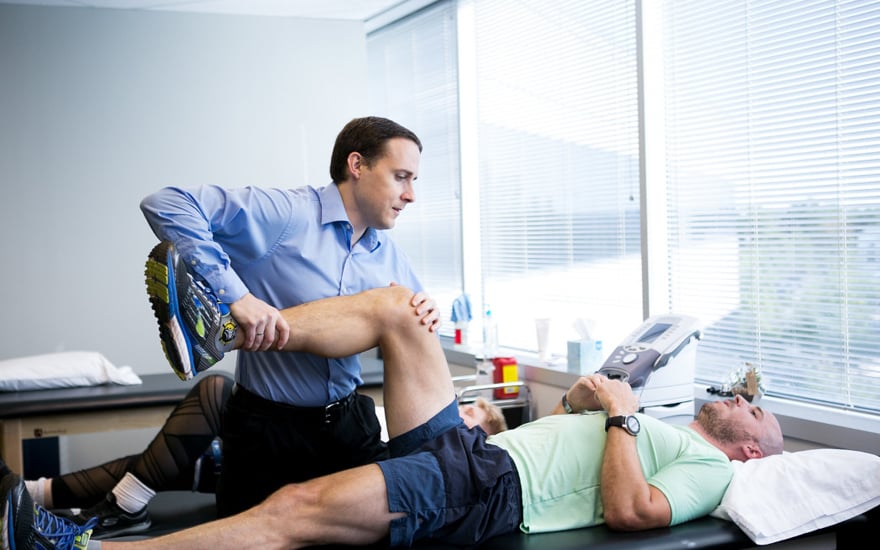Physical Therapy Guide to Shin Splints (Medial Tibial Stress Syndrome)
Medial tibial stress syndrome, also known as shin splints, causes pain on the inside of the shin, which is the front part of the leg between the knee and ankle. Shin splints affect the muscle and the bone to which it attaches, causing the connection between the muscle and shin bone to get irritated or even develop small tears due to overuse. Shin splints are a common injury among athletes, affecting up to 35% of those who run and jump, such as distance runners, sprinters, basketball or tennis players, and gymnasts. Military personnel, dancers, and other active people also get shin splints. Physical therapists help people with shin splints restore pain-free movement. They also teach exercises and how to prevent reinjury.
Physical therapists are movement experts. They improve quality of life through hands-on care, patient education, and prescribed movement. You can contact a physical therapist directly for an evaluation. To find a physical therapist in your area, visit Find a PT.
What Are Shin Splints?
Shin splints are a common overuse injury. They develop when too much stress is placed on the tibia (main shin bone). A recent increase in activity level, training regimen, or exercise routine usually precedes the onset of shin splints and pain. The muscles that attach to the tibia can cause an overload of stress on the bone with overuse. The muscles themselves also can become strained. The muscles involved in shin splints include the:
- Posterior tibialis muscle.
- Soleus muscle.
- Flexor digitorum longus muscle.
The most common risk factors for developing shin splints include:
- Female sex.
- Higher body weight.
- Flat feet or flattening of the arch of the foot (overpronation) while standing and walking or running.
- Excessive hip motion (the hip moves through a greater range than is typical).
- History of any previous running injury.
How Does It Feel?
If you have shin splints, you may feel pain in the middle or bottom third of the inside of your shin. The pain may be sharp when you touch the tender area or ache during or after exercise. Generally, the pain is provoked by activity and lessens with rest. When shin splints are developing, you may feel pain at the start of exercise, and it may be less noticeable as exercise progresses. Over time, the condition can worsen, and you may feel pain during and after exercise.
How Is It Diagnosed?
Your physical therapist will perform a thorough exam. This includes asking about your health history and watching you walk and do activities that cause your symptoms, like running or jumping.
Your physical therapist will test your strength, mobility, flexibility, and pain response. The most reliable symptom of shin splints is pain when pressing on certain spots on your shin.
If the exam suggests you have shin splints, your physical therapist will discuss your treatment goals with you and develop a specialized rehab program for you. If they suspect something more serious is causing your pain, they may refer you to a physician for more tests.
How Can a Physical Therapist Help?
A physical therapist will design a treatment plan just for you to help you recover from shin splints and reach your goals. They will work with you to change your training schedule so you can safely return to your activities. They will teach you ways to reduce the chances of reinjury.
To relieve pain, your physical therapist may prescribe:
- Resting from activity or exercise that causes pain.
- Icing the sore area for five to 10 minutes, one to three times a day.
- Exercises to gently stretch and strengthen the muscles around your shin.
- Taping the arch of your foot or the muscles in your leg.
- Massage for the muscles around your shins.
- Orthotics or shoe inserts if your feet flatten out too much or if your foot muscles are weak.

To strengthen weak muscles, your physical therapist may teach you:
- Exercises to make your core muscles stronger. These may include your abdominal and back muscles and muscles that enable hip movements (such as rotation, lifting the leg out to the side, or lifting the leg in front of or behind you). Strengthening your core can decrease stress on the lower leg.
- Exercises that increase your arch and shin muscle strength. These can help to decrease overpronation (flattening out) of the arch of the foot.
Your treatment also may include:
- A highly collaborative plan with you and your health care team for appropriate return to desired activities.
- Calf and foot muscle stretches.
- A pre-activity dynamic warm-up regimen.
- Single-leg exercises, including balancing, squats, reaching exercises, or heel raises.
- Modified takeoff and landing techniques for jumping athletes.
- Modified leg and foot control during walking and running.
- Suggestions for footwear that provides better support when walking or exercising.
Can This Injury or Condition Be Prevented?
To prevent shin splints, physical therapists recommend that you:
- Get a yearly functional fitness examination that assesses your strength, flexibility, and mobility and includes a sport-specific analysis.
- Perform dynamic stretches before exercising and static stretches after exercising.
- Perform strength and endurance exercises for the foot, hip, and pelvic muscles.
- Perform balance exercises on each leg.
- Follow a recommended training program when starting or increasing any exercise program. Shin splints are commonly seen in the early part of a person’s training or the beginning of an athlete’s season. All exercise programs should begin gently and progress slowly in duration and intensity.
- Choose appropriate footwear for the activity that is being performed.
- Choose appropriate cross-training activities to condition the core and leg muscles.
- Exercise on a softer, more pliable surface whenever possible.
Your physical therapist can teach you exercises to ensure maximum strength and health and prevent shin splints.
What Kind of Physical Therapist Do I Need?
All physical therapists are prepared through education and experience to treat a variety of conditions or injuries. You may want to consider:
- A physical therapist who is experienced in treating people with shin splints or MTSS, or who has experience treating individuals who participate in your sport or activity. Some physical therapists have a practice with an orthopedic (muscles, bones, and joints) sports focus.
- A physical therapist who is a board-certified clinical specialist or who completed a residency or fellowship in orthopedic or sports physical therapy. This physical therapist has advanced knowledge, experience, and skills that may apply to your condition.
You can find physical therapists who have these and other credentials by using Find a PT, the online tool built by the American Physical Therapy Association to help you search for physical therapists with specific clinical expertise in your geographic area.
General tips when you're looking for a physical therapist (or any other health care provider):
- Get recommendations from family, friends, or other health care providers.
- When you contact a physical therapy clinic for an appointment, ask about the physical therapists' experience in helping people with shin splints.
- Be prepared to describe your symptoms in as much detail as possible and say what makes your symptoms worse.
The American Physical Therapy Association believes that consumers should have access to information that can:
- Help them make health care decisions.
- Prepare them for a visit with their health care provider.
The following articles provide some of the best scientific evidence for the treatment of medial tibial stress syndrome. The articles report recent research and give an overview of the standards of practice in the United States and internationally. The article titles link either to a PubMed* abstract of the article or to the free full text to read or bring with you to your health care provider.
Bhusari N, Deshmukh M. Shin splint: a review. Cureus. 2023;15(1):e33905. Article Summary in PubMed.
Naderi A, Bagheri S, Ramazanian Ahoor F, et al. Foot orthoses enhance the effectiveness of exercise, shockwave, and ice therapy in the management of medial tibial stress syndrome. Clin J Sport Med. 2022;32(3):e251–e260. Article Summary in PubMed.
Mendez-Rebolledo G, Figueroa-Ureta R, Moya-Mura F, et al. The protective effect of neuromuscular training on the medial tibial stress syndrome in youth female track-and-field athletes: a clinical trial and cohort study. J Sport Rehabil. 2021;30(7):1019–1027. Article Summary in PubMed.
Menéndez C, Batalla L, Prieto A, et al. Medial tibial stress syndrome in novice and recreational runners: a systematic review. Int J Environ Res Public Health. 2020;17(20):7457. Article Summary in PubMed.
Reinking MF, Austin TM, Richter RR, et al. Medial tibial stress syndrome in active individuals: a systematic review and meta-analysis of risk factors. Sports Health. 2017;9(3):252–261. Article Summary in PubMed.
*PubMed is a free online resource developed by the National Center for Biotechnology Information. PubMed contains millions of citations to biomedical literature, including citations in the National Library of Medicine's MEDLINE database.
Expert Review:
Sep 10, 2024
Revised:
Oct 31, 2024
Content Type: Guide
Shin Splints
PT, DPT, board-certified clinical specialist in sports physical therapy
Derek Sople
PT, DPT, board-certified clinical specialist in orthopaedic physical therapy
You Might Also Like...
Health Tips
Top 4 Running Injuries Physical Therapists Help ManageFeb 11, 2019
There are numerous benefits to running, including improved cardiovascular, mental, and physical health, to name a few. Avid runners would love to live
Health Tips
8 Tips to Prevent Shin SplintsOct 2, 2018
Shin splints can be treated effectively. They also can be prevented with the help of a physical therapist when starting or intensifying an exercise program.

